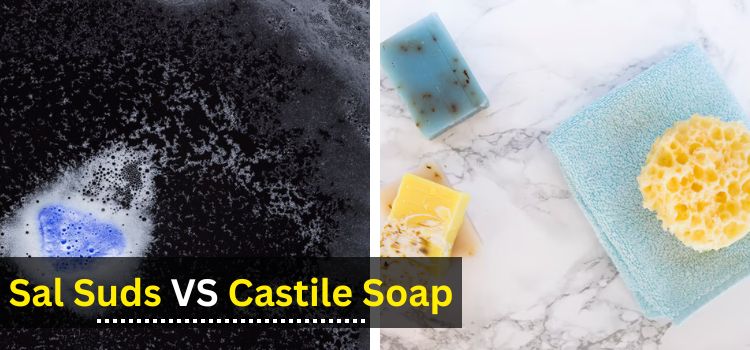In the realm of ménage cleaning products, the choice between Sal Suds and Castile soap can be a perplexing bone. Both products boast eco-friendly formulas and protean operations, but understanding the nuances of each can help you make an informed decision. In this composition, we embark on a trip to explore the parallels, differences, and unique rates of Sal Suds and Castile soap. From their composition and drawing power to their environmental impact and stoner reviews, we leave no gravestone unturned in our hunt to unravel the mystifications of these two famed cleansers. So, sit back, relax, and prepare to embark on a trip of discovery as we dive into the world of Sal Suds versus Castile soap.

Composition and constituents
Sal Suds, created by Dr. Bronner’s, features a blend of plant-based surfactants, including sodium lauryl sulfate and coco-betaine derived from coconut oil. These surfactants act as cleansers, effectively breaking down canvases and dirt for thorough cleaning. Also, Sal Suds contains sodium lauryl sulfate deduced from win kernel oil painting, which enhances its raging parcels and helps lift down smut. The addition of sodium lauryl sulfate in Sal Suds has sparked some contestation due to its eventuality for skin vexation in some individuals. Still, Dr. Bronner’s asserts that their expression is gentle enough for utmost druggies.
Castile soap, on the other hand, has a simpler composition, generally conforming of olive oil painting as the primary component, along with water and lye (sodium hydroxide) for saponification. Traditional Castile soap is made solely from olive oil painting, but ultramodern variations may include other factory-grounded canvases like coconut, hemp, or jojoba. The saponification process creates cleaner motes that attract both water and oil painting, allowing for effective sanctification without stripping down natural canvases from the skin.
Cleaning Power
Sal Suds is famed for its important cleaning capacities, particularly in cutting through tough grease and smut. It’s generally used for heavy-duty ménage tasks similar as washing dishes, drawing bottoms, and indeed diving out-of-door systems like washing buses or balconies. The combination of surfactants in Sal Suds creates a rich lather that fluently lifts down dirt and canvases, leaving shells sparkling clean.
Castile soap, while not as aggressive as Sal Suds, still boasts emotional cleaning power. Its gentle formula makes it suitable for a wide range of operations, including body marshland, soap, and indeed precious soap. Castile soap is particularly effective for sensitive skin and delicate shells, as it cleanses without harsh chemicals or complements.
Versatility
Both Sal Suds and Castile soap are prized for their versatility. Sal Suds can be used for a myriad of drawing tasks around the home, from mopping bottoms to washing laundry to drawing countertops. Its concentrated formula means that a little goes a long way, making it a cost-effective option for budget-conscious consumers.
Castile soap’s versatility extends beyond ménage cleaning to particular care routines. It serves as a gentle volition to traditional detergents, suitable for bathing, paring, and indeed washing hair. numerous druggies appreciate its mild nature, which makes it ideal for those with sensitive skin or disinclinations to harsh chemicals.
Environmental Impact
In the moment’s environmentally conscious society, the ecological footmark of drawing products is a significant consideration for numerous consumers. Both Sal Suds and Castile soap tout their eco-friendly credentials, with biodegradable formulas that break down harmlessly in the terrain.
Sal Suds’ factory-grounded constituents and biodegradable surfactants make it a popular choice for environmentally conscious consumers. Also, Dr. Bronner’s is committed to sustainability practices, including the use of recycled packaging accouterments and sourcing immorally sourced constituents.
Castile soap’s origins in natural canvases further enhance its eco-friendly profile. Olive oil painting, a crucial component in traditional Castile soap, is renewable and biodegradable, making it a sustainable choice for conscientious consumers. also, numerous brands offer Castile soap in minimum or plastic-free packaging, further reducing its environmental impact.
Price and Vacuity
When it comes to affordability and availability, both Sal Suds and Castile soap offer competitive options for consumers. Sal Suds, despite its concentrated formula, is priced competitively with other natural cleaning products on request. While the original cost may feel more advanced than conventional cleansers, its effectiveness and versatility make it a cost-effective choice in the long run. Sal Suds is extensively available online and in select retail stores, making it accessible for consumers to buy.
Castile soap, with its simple constituents and minimum processing, is frequently priced affordably, especially when bought in bulk or from budget-friendly brands. It’s readily available in health food stores, specialty shops, and online retailers, feeding to a wide range of consumers’ preferences and budgets.
Scent and Fragrance
The aroma of a cleaning product can significantly impact a consumer’s purchasing decision, and both Sal Suds and Castile soap offer a variety of scent options to suit individual preferences.
Sal Suds generally has a mild, pine- suchlike scent deduced from natural essential canvases, which numerous druggies find stimulating and amping. The subtle scent adds to the overall cleaning experience without overpowering other scents in the home.
Castile soap, on the other hand, comes in a wider range of scent options, from flowery to citrus to unscented kinds. Brands frequently incorporate natural essential canvases or botanical excerpts to produce charming scents that enhance the bathing or cleaning experience.
Packaging and Container
Packaging plays a pivotal part in the sustainability of a cleaning product, and both Sal Suds and Castile soap offer eco-friendly options for conscientious consumers. Sal Suds is generally packaged in recyclable plastic bottles, which may not be as environmentally friendly as glass or essence holders but can be reclaimed in numerous communities. Also, Dr. Bronner’s offers larger cache sizes to reduce packaging waste and encourage exercise.
Castile soap is available in a variety of packaging options, including plastic, glass, and indeed essence drums. numerous brands prioritize sustainability by offering refillable or bulk options, allowing consumers to reduce their plastic consumption and minimize waste.
Safety and Health Considerations
While both Sal Suds and Castile soap are generally considered safe for use, it’s essential to consider any implicit allergens or annoyances, especially for individuals with sensitive skin or respiratory conditions.
Sal Suds’ addition of sodium lauryl sulfate, a common surfactant set up in numerous cleaning products, may beget skin vexation or antipathetic responses in some individualities. still, the attention of sodium lauryl sulfate in Sal Suds is fairly low compared to other cleansers, making it less likely to beget adverse goods.
Castile soap, with its gentle expression and minimum constituents, is generally well-permitted by utmost druggies. still, some individualities may be sensitive to essential canvases or botanical excerpts used for scent, so it’s essential to perform a patch test before using Castile soap on large areas of the skin.
User Reviews and witnesses
Consumer feedback can give precious perceptivity into the efficacity and usability of drawing products like Sal Suds and Castile soap. numerous druggies praise Sal Suds for its cleaning power and versatility, noting its effectiveness in removing stubborn stains and odors from colorful shells.
Castile soap receives high marks from druggies for its gentle formula and mild sanctification parcels. numerous consumers appreciate its versatility for both ménage cleaning and particular care, noting its effectiveness as a soap, body marshland, and indeed laundry soap.
Myths and Misconceptions
Despite their fissionability, Sal Suds and Castile soap aren’t without their myths and misconceptions. One common misconception is that Sal Suds isn’t suitable for sensitive skin due to its addition of sodium lauryl sulfate. Still, Dr. Bronner’s asserts that Sal Suds is formulated to be gentle on the skin when used as directed. also, some people believe that Castile soap isn’t effective for heavy-duty cleaning tasks or that it leaves behind a residue on shells. While Castile soap may bear further elbow grease for tough stains, numerous druggies find it to be an effective and protean cleanser for a wide range of operations.
Brand Character and History
Bronner’s, the manufacturer of Sal Suds, has a long-standing character for producing high-quality eco-friendly products. The company’s commitment to social and environmental causes, along with its transparent sourcing and manufacturing practices, has earned it a pious following among consumers worldwide.
Castile soap has a rich history dating back centuries, with origins in the Castile region of Spain. Traditionally crafted from olive oil painting, Castile soap has evolved over time to include other factory-grounded canvases, but its commitment to natural constituents and traditional cleaner-making styles remains unchanged. numerous brands continue to uphold the heritage of Castile soap, offering high-quality products that prioritize sustainability and chastity.
Tips for Effective Use
To get the most out of Sal Suds and Castile soap, consider the following tips
• Adulterate Sal Suds according to the recommended rates for optimal cleaning power, especially for sensitive shells or individualities.
• Trial with different attention of Castile soap to find the right balance for your cleaning needs, as it can be used at full strength or adulterated for colorful operations.
• Use Sal Suds sparingly for heavily soiled particulars or shells, as a little goes a long way in breaking down dirt and grease.
• Incorporate essential canvases or natural complements into Castile soap for customized scents or added benefits, similar as lavender for relaxation or tea tree oil painting for its antibacterial parcels.
• Store both Sal Suds and Castile soap in a cool, dry place down from the direct sun to save their energy and extend their shelf life.
Final Word
In conclusion, the choice between Sal Suds and Castile soap eventually comes down to particular preferences and specific drawing requirements. Both products offer unique advantages and operations, making them precious additions to any ménage cleaning magazine. Whether you prioritize heavy-duty cleaning power or gentle, natural constituents, Sal Suds and Castile soap give effective and eco-friendly results for a cleaner, greener home.
FAQs
1. Is Sal Suds safe for use on all shells?
• Sal Suds is generally safe for use on utmost shells, but it’s always a good idea to perform a spot test in an invisible area first, especially for delicate or sensitive accouterments.
2. Can Castile soap be used as a soap?
• Yes, Castile soap can be used as a gentle soap, but be conservative as it may be drying for some hair types. Consider following up with a conditioner to restore humidity and help tangling.
3. Are there any essential canvases that shouldn’t be mixed with Sal Suds or Castile soap?
• Some essential canvases may interact with the constituents in Sal Suds or Castile soap, potentially affecting their efficacity or scent. It’s stylish to probe specific essential canvases and perform a small patch test before combining them withdrawing products.
4. Can Sal Suds and Castile soap be used together?
• Yes, Sal Suds and Castile soap can be used together for redundant cleaning power, especially for heavily soiled particulars or shells. still, it’s essential to adulterate them duly and avoid mixing inharmonious constituents to help adverse responses.
5. Are there any shells that shouldn’t be gutted with Sal Suds or Castile soap?
• Avoid using Sal Suds or Castile soap on untreated or closed shells, as well as shells sensitive to humidity or alkaline results. also, exercise caution when drawing delicate accouterments similar as hair, silk, or leather, as the strong cleaning agents may beget damage or abrasion.


